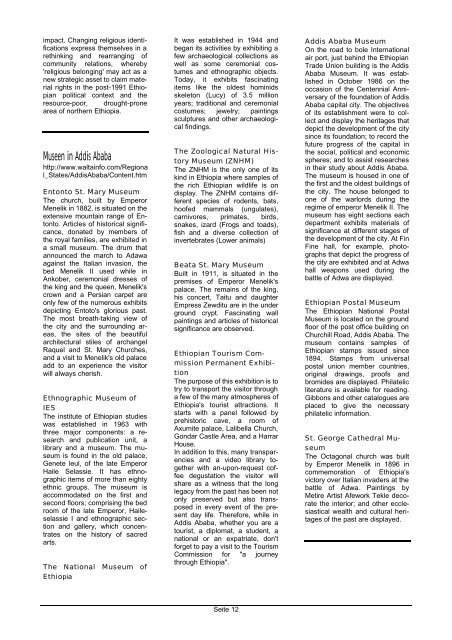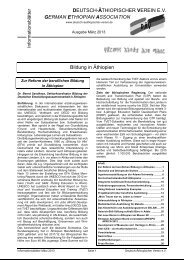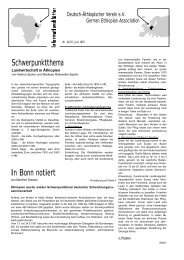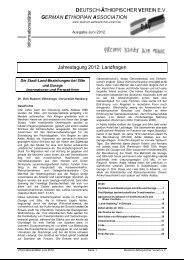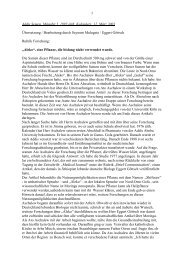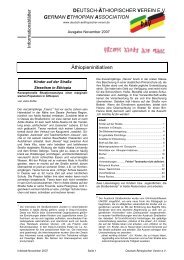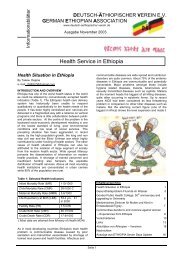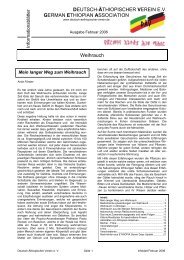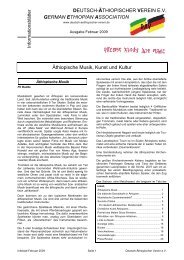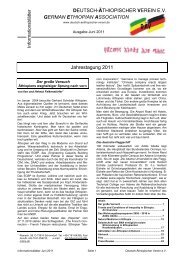Ethiopian Cultures and the Illusion of Ethiopian Culture - Deutsch ...
Ethiopian Cultures and the Illusion of Ethiopian Culture - Deutsch ...
Ethiopian Cultures and the Illusion of Ethiopian Culture - Deutsch ...
Create successful ePaper yourself
Turn your PDF publications into a flip-book with our unique Google optimized e-Paper software.
impact. Changing religious identifications<br />
express <strong>the</strong>mselves in a<br />
rethinking <strong>and</strong> rearranging <strong>of</strong><br />
community relations, whereby<br />
'religious belonging' may act as a<br />
new strategic asset to claim material<br />
rights in <strong>the</strong> post-1991 <strong>Ethiopian</strong><br />
political context <strong>and</strong> <strong>the</strong><br />
resource-poor, drought-prone<br />
area <strong>of</strong> nor<strong>the</strong>rn Ethiopia.<br />
Museen in Addis Ababa<br />
http://www.waltainfo.com/Regiona<br />
l_States/AddisAbaba/Content.htm<br />
Entonto St. Mary Museum<br />
The church, built by Emperor<br />
Menelik in 1882, is situated on <strong>the</strong><br />
extensive mountain range <strong>of</strong> Entonto.<br />
Articles <strong>of</strong> historical significance,<br />
donated by members <strong>of</strong><br />
<strong>the</strong> royal families, are exhibited in<br />
a small museum. The drum that<br />
announced <strong>the</strong> march to Adawa<br />
against <strong>the</strong> Italian invasion, <strong>the</strong><br />
bed Menelik II used while in<br />
Ankober, ceremonial dresses <strong>of</strong><br />
<strong>the</strong> king <strong>and</strong> <strong>the</strong> queen, Menelik's<br />
crown <strong>and</strong> a Persian carpet are<br />
only few <strong>of</strong> <strong>the</strong> numerous exhibits<br />
depicting Entoto's glorious past.<br />
The most breath-taking view <strong>of</strong><br />
<strong>the</strong> city <strong>and</strong> <strong>the</strong> surrounding areas,<br />
<strong>the</strong> sites <strong>of</strong> <strong>the</strong> beautiful<br />
architectural stiles <strong>of</strong> archangel<br />
Raquel <strong>and</strong> St. Mary Churches,<br />
<strong>and</strong> a visit to Menelik's old palace<br />
add to an experience <strong>the</strong> visitor<br />
will always cherish.<br />
Ethnographic Museum <strong>of</strong><br />
IES<br />
The institute <strong>of</strong> <strong>Ethiopian</strong> studies<br />
was established in 1963 with<br />
three major components: a research<br />
<strong>and</strong> publication unit, a<br />
library <strong>and</strong> a museum. The museum<br />
is found in <strong>the</strong> old palace,<br />
Genete leul, <strong>of</strong> <strong>the</strong> late Emperor<br />
Haile Selassie. It has ethnographic<br />
items <strong>of</strong> more than eighty<br />
ethnic groups. The museum is<br />
accommodated on <strong>the</strong> first <strong>and</strong><br />
second floors; comprising <strong>the</strong> bed<br />
room <strong>of</strong> <strong>the</strong> late Emperor, Haileselassie<br />
I <strong>and</strong> ethnographic section<br />
<strong>and</strong> gallery, which concentrates<br />
on <strong>the</strong> history <strong>of</strong> sacred<br />
arts.<br />
The National Museum <strong>of</strong><br />
Ethiopia<br />
It was established in 1944 <strong>and</strong><br />
began its activities by exhibiting a<br />
few archaeological collections as<br />
well as some ceremonial costumes<br />
<strong>and</strong> ethnographic objects.<br />
Today, it exhibits fascinating<br />
items like <strong>the</strong> oldest hominids<br />
skeleton (Lucy) <strong>of</strong> 3.5 million<br />
years; traditional <strong>and</strong> ceremonial<br />
costumes; jewelry; paintings<br />
sculptures <strong>and</strong> o<strong>the</strong>r archaeological<br />
findings.<br />
The Zoological Natural History<br />
Museum (ZNHM)<br />
The ZNHM is <strong>the</strong> only one <strong>of</strong> its<br />
kind in Ethiopia where samples <strong>of</strong><br />
<strong>the</strong> rich <strong>Ethiopian</strong> wildlife is on<br />
display. The ZNHM contains different<br />
species <strong>of</strong> rodents, bats,<br />
ho<strong>of</strong>ed mammals (ungulates),<br />
carnivores, primates, birds,<br />
snakes, izard (Frogs <strong>and</strong> toads),<br />
fish <strong>and</strong> a diverse collection <strong>of</strong><br />
invertebrates (Lower animals)<br />
Beata St. Mary Museum<br />
Built in 1911, is situated in <strong>the</strong><br />
premises <strong>of</strong> Emperor Menelik's<br />
palace. The remains <strong>of</strong> <strong>the</strong> king,<br />
his concert, Taitu <strong>and</strong> daughter<br />
Empress Zewditu are in <strong>the</strong> under<br />
ground crypt. Fascinating wall<br />
paintings <strong>and</strong> articles <strong>of</strong> historical<br />
significance are observed.<br />
<strong>Ethiopian</strong> Tourism Commission<br />
Permanent Exhibition<br />
The purpose <strong>of</strong> this exhibition is to<br />
try to transport <strong>the</strong> visitor through<br />
a few <strong>of</strong> <strong>the</strong> many atmospheres <strong>of</strong><br />
Ethiopia's tourist attractions. It<br />
starts with a panel followed by<br />
prehistoric cave, a room <strong>of</strong><br />
Axumite palace, Lalibella Church,<br />
Gondar Castle Area, <strong>and</strong> a Harrar<br />
House.<br />
In addition to this, many transparencies<br />
<strong>and</strong> a video library toge<strong>the</strong>r<br />
with an-upon-request c<strong>of</strong>fee<br />
degustation <strong>the</strong> visitor will<br />
share as a witness that <strong>the</strong> long<br />
legacy from <strong>the</strong> past has been not<br />
only preserved but also transposed<br />
in every event <strong>of</strong> <strong>the</strong> present<br />
day life. Therefore, while in<br />
Addis Ababa, whe<strong>the</strong>r you are a<br />
tourist, a diplomat, a student, a<br />
national or an expatriate, don't<br />
forget to pay a visit to <strong>the</strong> Tourism<br />
Commission for "a journey<br />
through Ethiopia".<br />
Seite 12<br />
Addis Ababa Museum<br />
On <strong>the</strong> road to bole International<br />
air port, just behind <strong>the</strong> <strong>Ethiopian</strong><br />
Trade Union building is <strong>the</strong> Addis<br />
Ababa Museum. It was established<br />
in October 1986 on <strong>the</strong><br />
occasion <strong>of</strong> <strong>the</strong> Centennial Anniversary<br />
<strong>of</strong> <strong>the</strong> foundation <strong>of</strong> Addis<br />
Ababa capital city. The objectives<br />
<strong>of</strong> its establishment were to collect<br />
<strong>and</strong> display <strong>the</strong> heritages that<br />
depict <strong>the</strong> development <strong>of</strong> <strong>the</strong> city<br />
since its foundation; to record <strong>the</strong><br />
future progress <strong>of</strong> <strong>the</strong> capital in<br />
<strong>the</strong> social, political <strong>and</strong> economic<br />
spheres; <strong>and</strong> to assist researches<br />
in <strong>the</strong>ir study about Addis Ababa.<br />
The museum is housed in one <strong>of</strong><br />
<strong>the</strong> first <strong>and</strong> <strong>the</strong> oldest buildings <strong>of</strong><br />
<strong>the</strong> city. The house belonged to<br />
one <strong>of</strong> <strong>the</strong> warlords during <strong>the</strong><br />
regime <strong>of</strong> emperor Menelik II. The<br />
museum has eight sections each<br />
department exhibits materials <strong>of</strong><br />
significance at different stages <strong>of</strong><br />
<strong>the</strong> development <strong>of</strong> <strong>the</strong> city. At Fin<br />
Fine hall, for example, photographs<br />
that depict <strong>the</strong> progress <strong>of</strong><br />
<strong>the</strong> city are exhibited <strong>and</strong> at Adwa<br />
hall weapons used during <strong>the</strong><br />
battle <strong>of</strong> Adwa are displayed.<br />
<strong>Ethiopian</strong> Postal Museum<br />
The <strong>Ethiopian</strong> National Postal<br />
Museum is located on <strong>the</strong> ground<br />
floor <strong>of</strong> <strong>the</strong> post <strong>of</strong>fice building on<br />
Churchill Road, Addis Ababa. The<br />
museum contains samples <strong>of</strong><br />
<strong>Ethiopian</strong> stamps issued since<br />
1894. Stamps from universal<br />
postal union member countries,<br />
original drawings, pro<strong>of</strong>s <strong>and</strong><br />
bromides are displayed. Philatelic<br />
literature is available for reading.<br />
Gibbons <strong>and</strong> o<strong>the</strong>r catalogues are<br />
placed to give <strong>the</strong> necessary<br />
philatelic information.<br />
St. George Ca<strong>the</strong>dral Museum<br />
The Octagonal church was built<br />
by Emperor Menelik in 1896 in<br />
commemoration <strong>of</strong> Ethiopia's<br />
victory over Italian invaders at <strong>the</strong><br />
battle <strong>of</strong> Adwa. Paintings by<br />
Metire Artist Afework Tekle decorate<br />
<strong>the</strong> interior; <strong>and</strong> o<strong>the</strong>r ecclesiastical<br />
wealth <strong>and</strong> cultural heritages<br />
<strong>of</strong> <strong>the</strong> past are displayed.


